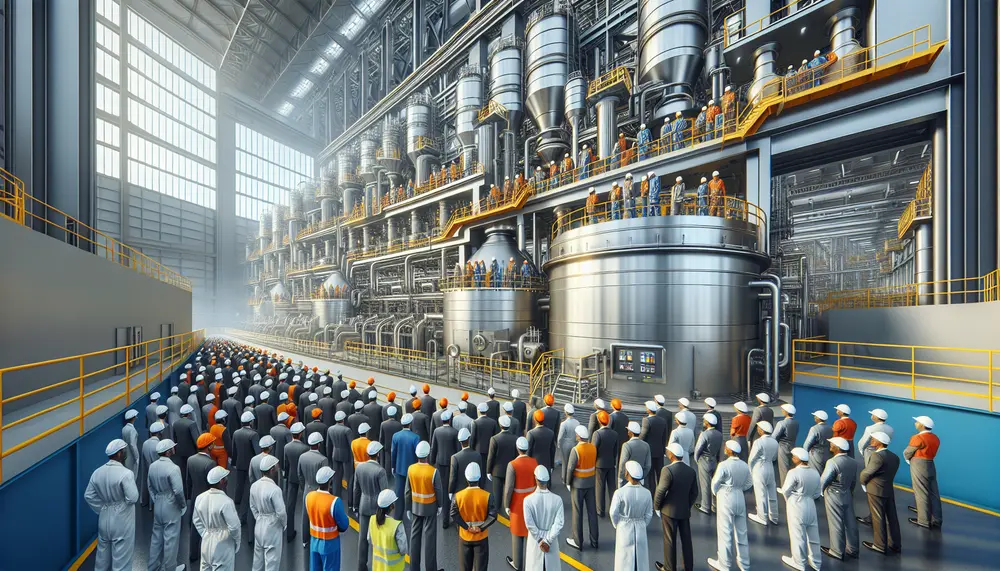Table of Contents:
Understanding the Basics of Steel Making Vacuum Degassing
Vacuum degassing is a crucial process in steel making, primarily aimed at improving the overall quality of the steel. This process involves the removal of dissolved gases from molten metal under vacuum conditions. The primary gases targeted are hydrogen, oxygen, and nitrogen, which can cause numerous problems in the final steel product, including porosity, embrittlement, and degraded mechanical properties.
The procedure is typically carried out in a specially designed chamber where the steel is exposed to low pressures, creating a partial vacuum. Under these conditions, the solubility of gases in metal decreases significantly, causing the gases to bubble out of the molten steel. A key aspect of the process is maintaining a balance between pressure and temperature to optimize gas removal without compromising the integrity of the steel.
Vacuum degassing is often integrated into the steel production line following the initial melting and refining stages. The timing and specific conditions under which degassing is performed can vary depending on the composition of the steel and the final properties required.
By improving the purity and ductility of steel, vacuum degassing plays a pivotal role in enhancing the material’s performance in high-stress applications like construction, automotive, and aerospace industries. The precise control of this process allows manufacturers to meet strict specifications and ensure the reliability and safety of their steel products.
Key Benefits of Vacuum Degassing in Steel Production
The implementation of vacuum degassing in steel production offers several distinctive benefits that are crucial for both the quality of the steel and the efficiency of the production process. These advantages include:
- Enhanced Mechanical Properties: Vacuum degassing helps in achieving a cleaner steel with fewer impurities, which translates into higher tensile strength, improved toughness, and better fatigue resistance. These properties are essential for applications requiring high performance under extreme conditions.
- Improved Machinability: By removing gases and minimizing impurities, steel becomes more homogeneous. This uniformity allows for smoother machining and forming processes, leading to higher precision in finished products.
- Decreased Rejection Rates: The consistency in quality facilitated by vacuum degassing reduces the likelihood of defects, thus lowering the rejection rates in manufacturing processes. This reliability is particularly valued in industries where material failure can have severe implications, such as in aerospace and automotive sectors.
- Better Weldability: Removing gases such as hydrogen significantly reduces the risk of weld cracking, making the steel safer and more effective to use in welded structures. This property is highly beneficial in industries where welding is a common practice.
- Cost-Effective Production: Despite the initial investment in vacuum degassing equipment, the overall cost benefits include reduced scrap, lower corrective processing needs, and enhanced product lifespan, all contributing to a more economical manufacturing cycle.
Furthermore, these benefits are not just limited to improving the quality of the steel but also extend to environmental advantages. By producing steel with fewer impurities, less energy is required in post-processing steps, leading to a decrease in carbon footprint.
| Benefit | Description |
|---|---|
| Mechanical Properties | Higher strength and durability. |
| Machinability | Consistent and precise manufacturing. |
| Quality Control | Low defect and rejection rates. |
| Weldability | Reduction in welding issues such as cracking. |
| Cost Efficiency | Lower long-term production and repair costs. |
In summary, vacuum degassing is a transformative step in steel production that significantly enhances the quality of steel while offering substantial operational benefits.
How Vacuum Degassing Works: A Step-by-Step Guide
Vacuum degassing of steel is a refined process that requires careful control of several variables to ensure the elimination of unwanted gases effectively. Here, we delve into a step-by-step understanding of how vacuum degassing operates in a steel production environment:
- Preparation of Molten Steel: Steel is melted and refined conventionally in a furnace. Once the desired chemical composition and temperature are achieved, the molten steel is ready for the degassing process.
- Transfer to the Degassing Chamber: The molten steel is then transported from the furnace to a vacuum degassing chamber. This transfer is typically achieved via a ladle that is moved with precision using overhead cranes.
- Establishing a Vacuum: The chamber is sealed, and a high-powered vacuum pump system evacuates air and gases from the chamber, reducing the pressure significantly. This creates a partial vacuum state where the pressure is typically less than 1 millibar (
FAQ: Enhancing Steel Quality Through Vacuum Degassing
What is vacuum degassing in steel production?
Vacuum degassing is a process used in steel making to remove dissolved gases, such as hydrogen, nitrogen, and oxygen, from molten steel. This is achieved by exposing the steel to low pressure, which reduces the solubility of gases and helps in their removal, thereby enhancing the steel's ductility and overall quality.
Why is vacuum degassing important for steel quality?
Vacuum degassing is critical for improving the mechanical properties of steel, such as tensile strength, toughness, and weldability. It helps in reducing internal defects and impurities, which can lead to improved performance in high-stress applications in industries like automotive and aerospace.
How does vacuum degassing improve the machinability of steel?
By removing gases and minimizing impurities, vacuum degassing leads to a more uniform and homogeneous steel composition. This uniformity allows for smoother machining and forming processes, leading to higher precision in finished products and reducing the likelihood of machining errors.
What steps are involved in the vacuum degassing process?
The vacuum degassing process typically involves transferring molten steel to a sealed chamber, creating a vacuum to lower gas solubility, agitating the steel to release dissolved gases, and careful monitoring and control of pressure and temperature to optimize the degassing results.
Can vacuum degassing help in reducing steel production costs?
Yes, vacuum degassing can contribute to cost reductions in steel production by lowering the rejection rates due to defects, decreasing the need for additional processing to correct impurities, and improving the overall yield and efficiency of the production process.





